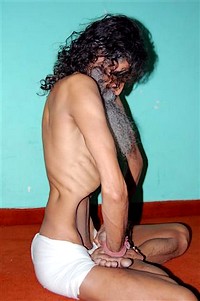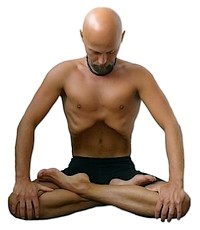Mula Bandha practice is important for muladhara chakra activation, for body vitality and for the control of desire.
Mula Bandha Definition
In Sanskrit Mula means “root”, and Bandha means “lock”, so it can be literally translated as a “root lock”, but this translation gives no clue of the asana or Bandha meaning. Mula here can mean two things: muladhara chakra where Kundalini sits, and the foundation of the spine, the perineum.
The practice of Mula Bandha is mentioned in ancient yoga shastras, for example, in Hatha Yoga Pradipika, in fourth chapter, verse 61, where it is said: “Press the heels to the perineum, while contracting the perineum muscles. Pull apana upward. This is known as Mula Bandha”. Apana here refers to the internal air channels in the body called vayu, which carries the energy throughout the body.
Mula Bandha is also mentioned in Gheranda Samhita and Yoga Chudamani Upanishada.
Mula Bandha Instruction
The place or the spot which needs to be contracted can activate muladhara chakra, and this spot is slightly different in men and women due to the differences in physiology.
Men: in the perineum, between anus and genitals. Women: in the cervix area, which connects the uterus with the vagina? Mula Bandha is often performed improperly by contracting the anus. This is another technique called ashvini mudra.
Mula Bandha Poses
The best yoga pose for Mula Bandha is siddhasana for men and siddha yoni asana for women. In each of these poses one heel presses against the muladhara area to stimulate its physical contraction. If you cannot sit in these asanas, then take any other pose for meditation where your knees are on the ground. It can be padmasana, svastikasana, bajrasana or ardha padmasana.
Mula Bandha Exercise (the technique)
 Sit in a comfortable pose (one of the mentioned above). Place your palms on your knees (or lap). Close your eyes and relax. Inhale deeply, hold your breath and perform jalandhara bandha (throat lock). After jalandhara, contract the muscles in the muladhara chakra area. Pull these muscles up as far as you can, but do not overstrain yourself. Your attention should be focused on the spot we talked about before – the place of muladhara chakra activation. Keep this contraction as long as you can, then release. Stop doing jalandhara bandha, raise your head and exhale. This is one cycle of Mula Bandha exercise. Before you start the next cycle let your breath become normal. Do several cycles but keep it easy and do not stress yourself too much with the Bandha.
Sit in a comfortable pose (one of the mentioned above). Place your palms on your knees (or lap). Close your eyes and relax. Inhale deeply, hold your breath and perform jalandhara bandha (throat lock). After jalandhara, contract the muscles in the muladhara chakra area. Pull these muscles up as far as you can, but do not overstrain yourself. Your attention should be focused on the spot we talked about before – the place of muladhara chakra activation. Keep this contraction as long as you can, then release. Stop doing jalandhara bandha, raise your head and exhale. This is one cycle of Mula Bandha exercise. Before you start the next cycle let your breath become normal. Do several cycles but keep it easy and do not stress yourself too much with the Bandha.
As for the Mula Bandha breathing, although I didn’t stress it too much here, yet it is important to follow the process described. If you feel it difficult to follow, then reduce the number of cycles of the Bandha. The key point with the breathing is that it should be done through your nose; it should be deep but not overstressed. Your attention is also very important as it draws the prana or our bodily internal energy to the place the focus is laid upon.
Mula Bandha and uddiyana bandha are important practices to restore our body’s energy levels and control sexual desire. They also help to rejuvenate the body if done properly and regularly.
Mula Bandha and Pregnancy
The practice of Mula Bandha is actually beneficial for childbirth, especially if you practice it before the conception. But even during pregnancy it is still beneficial. During pregnancy you need engage the muscles in the area near the cervix but along the way avoiding the uterine contractions. You may feel the Bandha more comfortable once the baby raises higher, which happens around 5-6 month. Mula Bandha is also good for postpartum period.
If you like doing uddiyana bandha, which usually becomes impossible while being pregnant, you can substitute it with Mula Bandha without losing all the benefits of Uddiyana Bandha.
I would say that the Mula Bandha benefits are similar to those of Uddiyana thought there is some difference between them, since Mula Bandha is more about focusing on muladhara, while Uddiyana works great for the abdominal organs as well as svadhisthana chakra. But both work on muladhara as well, and can be interchanged in times if needed.
Mula Bandha Benefits
Mulabandhasana helps restore the body’s vitality, its energy and slow down the aging process. This things are the keys to great health because once your energy is restored, the healing process goes faster, and your health gets better. Just keep in mind that the master key of the practice is your full attention to the contracted area and to the whole process. It may be difficult to do everything properly for beginners, but after a while you will master it and reap the full benefits of the Bandha.


I encourage everyone to incorporate mula bandha into their regular Yoga practice. It’s essential for optimal health. A lot of yogis are confused about it though. There are many people teaching a lot of different things.
You are right: mula bandha is a very effective technique, but it requires the right approach and taking the proper method.
How a pregnant woman should do Mula Bandha? with or without air retention?
Yes, the air retention is there, but you should not push it too much; the main criteria is the feeling of comfort, especially when doing Mula Bandha in pregnancy. If it is too difficult, just reduce the number of times you do the bandha.